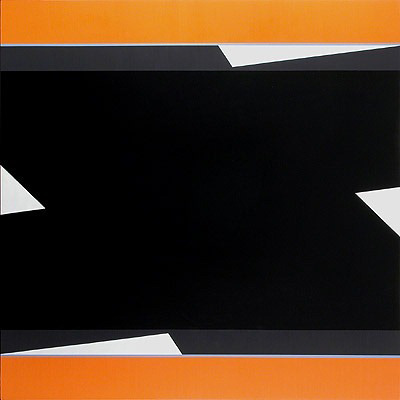
September 21, 2011

‘Carré’ Oil on wood by Don Voisine, 44 by 44 inches, 2011
Don Voisine’s careful placements at Icon
Reading shapes
By Ken Greenleaf
In his essays on interpretation in the 1970s, Frank Kermode assigned a couple of conditions to the apprehension of a text: carnal and spiritual. The carnal is the work at its most explicit; the spiritual is the penumbra of awareness that develops around it. Thoughts like these come to mind at the excellent show of new paintings by Don Voisine at Icon Contemporary Art. The show is similar to, but a bit larger than, the one that I saw at McKenzie Fine Art in New York earlier this year, and both confirm that Voisine is an artist of depth and accomplishment.
At their simplest level (Kermode's carnal) these paintings are exercises in the abstract arrangement of simple shapes, usually hard-edged black masses surrounded by stripes of color. An example is "Carré," a square painting 44 inches on a side. The center of the work is dominated by a thick black "Z"-shape, apparently overlaying a dark gray "X"-shape. These could be also read as dark shapes punctuated by white triangles — the ambiguity is deliberate, and purposeful to how the paintings work. Wide orange stripes form the top and bottom borders and thin light-blue lines separate the orange stripes from the defining masses in the picture's center. "Carré" thus appears as a fairly complex and sophisticated exercise in design. As an object we can, correctly enough, see it as distinct from any personal metaphysics, as if were simply an object in space, Kant's thing in itself.
But all works of art have context, and it is clear from all we know about art that Voisine intends something much more than to just amuse us with his graphic skills. The shapes and panels are familiar and uncomplicated, what you might find in a pile of stone blocks. What makes these paintings the significant works of art they are is the way they resonate with our own awareness of our surroundings. The paintings have personality, emotional reality, intellectual curiosity, and passion. They create themselves as we look at them (Kermode's spiritual).
The geometries involved have a slight discontinuity that nearly creates an illusion of space, but not quite. There's a tension between the graphic plainness and the depths of the mass. We can simultaneously stand outside them and see them as paint on a board (these are oil paint on panels, by the way) and be drawn into an internal dialogue around the suggestion of illusion. It's a self-referential recursive philosophical presence that is at the heart of the modernist idea, going back to the turn of the 20th century and still the latent center of virtually all art made since.
In such strict economy of means every element becomes critically important. Voisine selects his hues, tones, shapes, relationships, and finish with great care. His process is irrelevant and properly hidden, but it seems likely that he makes his choices through multiple re-workings until everything fits together with a comprehensive sense of rightness. The dominating blacks, for instance, are warm and friendly, and the mood of the show as a whole is open and inviting.
Voisine's decisions are not merely personal, but also introspective to a degree that gives his work a transcendent feeling that it is possible to be awake to one's surroundings. We come to any show hoping for an encounter that will bring us to a sense of deep communion with a consciousness outside our own — it is the reason we learn to look at art, the same way we learn to listen to music. We expect a level of commitment to excellence, and rarely find it. Looking at a show of Voisine's paintings restores our faith that a high level of excellence can still be achieved, and the enterprise of art itself has a special human value all its own.